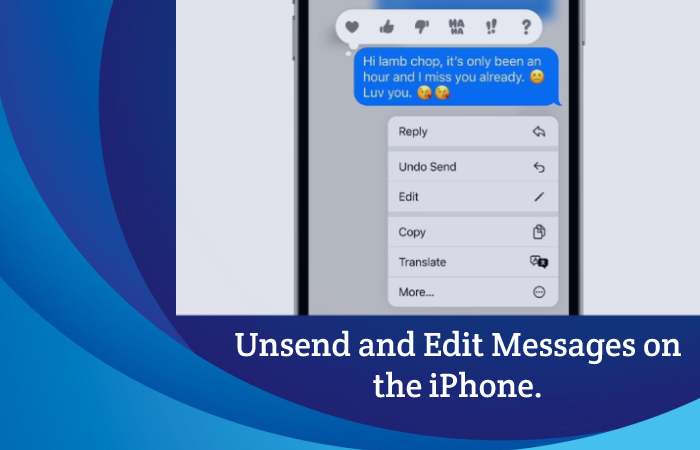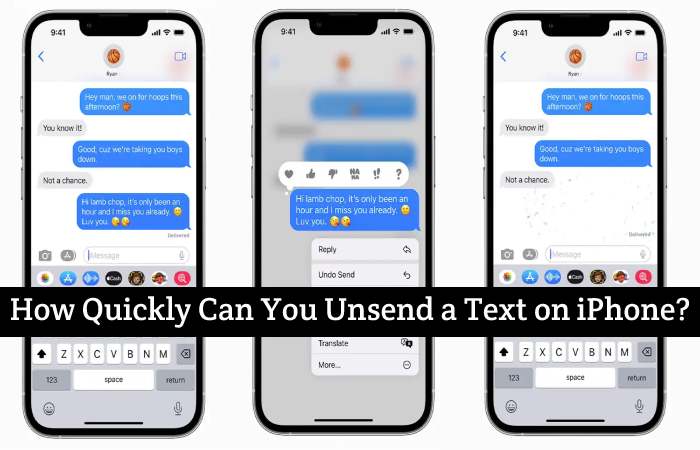Table of Contents
Introduction
You have 2 minutes to Unsend a message on your iPhone. After 2 minutes have passed, the selection to Unsend the message will no longer be available.
So, You can Unsend a message on an iPhone using the Messages app, but this feature has a time limit. Introduced in iOS 14, this capability is called “Message Recall.” It allows you to retract a message or media file sent through iMessage or MMS, but only if the recipient hasn’t seen it yet. Here’s how it works:
You can typically Unsend a message within a time frame of a few minutes after sending it. The recall option becomes unavailable once the recipient opens and views the message. To use this feature, long-press the sent message, tap “Recall,” and the message will be replaced with a notice saying that the message was recalled.
This introduction provides an overview of the message recall feature on iPhones, emphasizing the time sensitivity of the action.
Unsend and Edit Messages on the iPhone.
To Unsend or edit a message on an iPhone, you can follow these steps:
To Unsend a message:
- Open the Messages app.
- Tap and hold the message you want to Unsend.
- Tap “Undo Send.”
- To edit a message:
Open the Messages app.
- Tap and hold the message you want to edit.
- Tap “Edit.”
- You can edit the message & then tap “Done” to send it.
Note that you can only Unsend or edit messages sent to other iPhone users. You cannot Unsend or edit messages sent to Android users or other devices that do not support the feature.
Also, you can only Unsend or edit messages within 2 minutes of sending them. If you try to Unsend or edit a message after 2 minutes have passed, the option will not be available.
How Quickly Can You Unsend a Text on iPhone?
You can Unsend a text on an iPhone within 2 minutes of sending it. After 2 minutes have passed, the selection to Unsend the message will no longer be available.
To Unsend a text on an iPhone, follow these steps:
- Open the Messages app.
- Find the message you want to Unsend and tap and hold it.
- Tap “Undo Send.”
If you try to Unsend a text after 2 minutes, you will see a message that says, “Can’t undo sending a message.”
Here are some reasons why you may not be able to Unsend a text:
- You are not using the latest version of iOS.
- You are texting someone using an Android phone or another device not support the feature.
- You have already sent the reader more than 2 minutes ago.
If you cannot Unsend a text, you can try deleting the text instead. However, this will only delete the text on your phone. The reader will still be visible on the recipient’s phone.
How do you Delete Text Messages on all sides of an iPhone?
There is no way to delete text messages on both sides of the iPhone. Once you send a text message, the recipient has a copy of it on their phone, and there is no way to delete it from their phone without their permission.
However, you can delete text messages from your phone and ask the recipient to delete the messages from their phone.
To delete text messages from your iPhone, follow these steps:
- Open the Messages app.
- Find the message or conversation you want to delete and swipe left.
- Tap Delete.
To ask the recipient to delete the text messages from their phone, you can send them a letter asking them to do so.
It is important to note that even if you delete a text message from your phone, it may still be stored on Apple’s servers for some time. It is so that Apple can help you recover deleted messages if needed.
If you are concerned about the privacy of your text messages, you can use a third-party messaging app that encrypts your messages. It will make it more difficult for people to intercept or access your notes without your permission.
Why can’t I Unsend a Text to Apple?
There are a few reasons why you can’t Unsend a text message on Apple:
- Security: When you send a text message on Apple, it is encrypted and sent to the recipient’s device. This encryption protects your privacy and makes it more difficult for people to intercept your messages. However, it also means that Apple cannot Unsend the message for you once it has been sent.
- Performance: Apple has millions of users sending and receiving daily text messages. If Apple were to allow users to Unsend messages, it would need to store a copy of every message sent. It would strain Apple’s servers and make the messaging service slower or less reliable.
- User experience: If Apple allows users to Unsend messages, it could create confusion and frustration for both the sender and the recipient. For example, the recipient of a message may see the message and then receive a notification that the message has been unsent. It could lead to misunderstandings and conflict.
For these reasons, Apple has decided not to allow users to Unsend text messages. However, Apple does allow users to delete text messages from their own devices. Users can also ask the recipient to delete the messages from their device.
If you are concerned about the privacy of your text messages, you can use a third-party messaging app that encrypts your messages. It will make it more difficult for people to intercept or access your notes without your permission.
Conclusion
You have 2 minutes to Unsend a message on your iPhone. After 2 minutes have passed, the choice to Unsend the message will no longer be available.
Here is a summary of the key points about unending messages on iPhone:
- You can only Unsend messages that you have sent to other iPhone users.
- You cannot Unsend messages sent to Android users or other devices that do not support the feature.
- You can only Unsend messages within 2 minutes of sending them. If you try to Unsend a message after 2 minutes have passed, the option will not be available.
- When you Unsend a message, the receiver will receive a notice saying, “Message unsent.”
- If the recipient has already seen the message before you Unsend it, they will still be able to see the message.
If you cannot Unsend a message, you can try deleting the message instead. However, this will only delete the message on your phone. The message will still be visible on the recipient’s phone.


